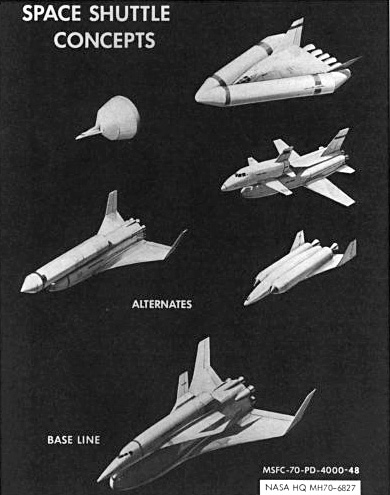Datei:Space Shuttle concepts.jpg
Space_Shuttle_concepts.jpg (390 × 495 Pixel, Dateigröße: 89 KB, MIME-Typ: image/jpeg)
Diese Datei stammt aus Wikimedia Commons und kann von anderen Projekten verwendet werden. Die Beschreibung von deren Dateibeschreibungsseite wird unten angezeigt.
Beschreibung
| BeschreibungSpace Shuttle concepts.jpg |
Space Shuttle Concepts illustration showing late 1960's designs, part of the Phase A-prime process. The baseline design at the bottom represents a composite of features from different individual designs that met the Manned Spacecraft Center's (MSC) basic requirements spec. All of these were based on a two-stage design, with both stages manned and capable of a horizontal landing. This design had evolved out of a series of evolutionary studies during the Phase A process, and NASA planners became concerned that the resulting designs were too focused on the two-stage concept. So as part of an A' series, they asked for more radical solutions. Some of the results are shown as the upper five concepts in this image. The two designs directly above the baseline concept were variations on the basic concept; on the right the fly-back booster has been replaced by two large booster rockets running down the side of the fuselage, while on the left the orbiter has been replaced by a conventional disposable rocket on top of the baseline booster. In the middle-right is the North American DC-3 concept developed by Maxime Faget's team at the Marshall Space Flight Center (MSFC). This was largely a replacement of the MSC's delta-wing design with straight wings, which offered better performance and far more flexibility to change the position of the wing in the case of the almost unavoidable changes in center of gravity. In spite of never being a serious contender for the Shuttle program, the team was able to secure considerable funding, developing free-flight models and creating extensive design materials which were found in publications well into the 1970s. At the top are the two most radical concepts, the Lockheed Star Clipper on the right and the Chrysler SERV on the left. The Star Clipper (and the somewhat similar McDonnell Douglas proposal, Tip Tank) were stage-and-a-half designs using a single powered orbiter combined with disposable drop tanks. SERV was the most radical design by far, a single-stage-to-orbit (SSTO) vehicle using an advanced engine design capable of completely automated missions. In this illustration SERV is shown with a fly-back shuttle on top, the MURP. The various designs are not shown to scale. DC-3 is somewhat larger than the baseline design, and SERV is larger than any of them - the MURP was roughly the size of the DC-3 orbiter, which provides some sense of scale. Forces outside of NASA's control led to dramatic changes to the program scope. These designs were intended to launch a maximum of 35,000 lbs eastward from Kennedy, which would limit their polar capability to perhaps 20,000 lbs. In order to ensure funding, NASA asked the Air Force to join the program and cancel their own Titan IIIN design. However, IIIN had been designed specifically to launch spy satellites as large as 40,000 lbs into polar orbit, the equivalent of launching 65,000 lbs east from Kennedy. None of the Phase B designs could be scaled to this size without enormous increases in price, and this led to the semi-reusable design that eventually went into service. |
| Quelle | NASA-Website |
| Urheber | NASA |
| Genehmigung (Weiternutzung dieser Datei) |
PD |
Lizenz
| Public domainPublic domainfalsefalse |
| Diese Datei ist gemeinfrei (public domain), da sie von der NASA erstellt worden ist. Die NASA-Urheberrechtsrichtlinie besagt, dass „NASA-Material nicht durch Urheberrecht geschützt ist, wenn es nicht anders angegeben ist“. (NASA-Urheberrechtsrichtlinie-Seite oder JPL Image Use Policy). |  | |
 |
Warnung:
|
Dateiversionen
Klicke auf einen Zeitpunkt, um diese Version zu laden.
| Version vom | Vorschaubild | Maße | Benutzer | Kommentar | |
|---|---|---|---|---|---|
| aktuell | 13:55, 23. Apr. 2012 |  | 390 × 495 (89 KB) | wikimediacommons>Soerfm | Contrast |
Dateiverwendung
Die folgende Seite verwendet diese Datei:
Metadaten
Diese Datei enthält weitere Informationen, die in der Regel von der Digitalkamera oder dem verwendeten Scanner stammen. Durch nachträgliche Bearbeitung der Originaldatei können einige Details verändert worden sein.
| Kameraausrichtung | Normal |
|---|---|
| Horizontale Auflösung | 150 dpi |
| Vertikale Auflösung | 150 dpi |
| Software | Adobe Photoshop CS2 Windows |
| Speicherzeitpunkt | 15:54, 23. Apr. 2012 |
| Farbraum | Nicht kalibriert |
| Bildbreite | 390 px |
| Bildhöhe | 495 px |
| Digitalisierungszeitpunkt | 17:52, 23. Apr. 2012 |
| Datum zu dem die Metadaten letztmalig geändert wurden | 17:54, 23. Apr. 2012 |
